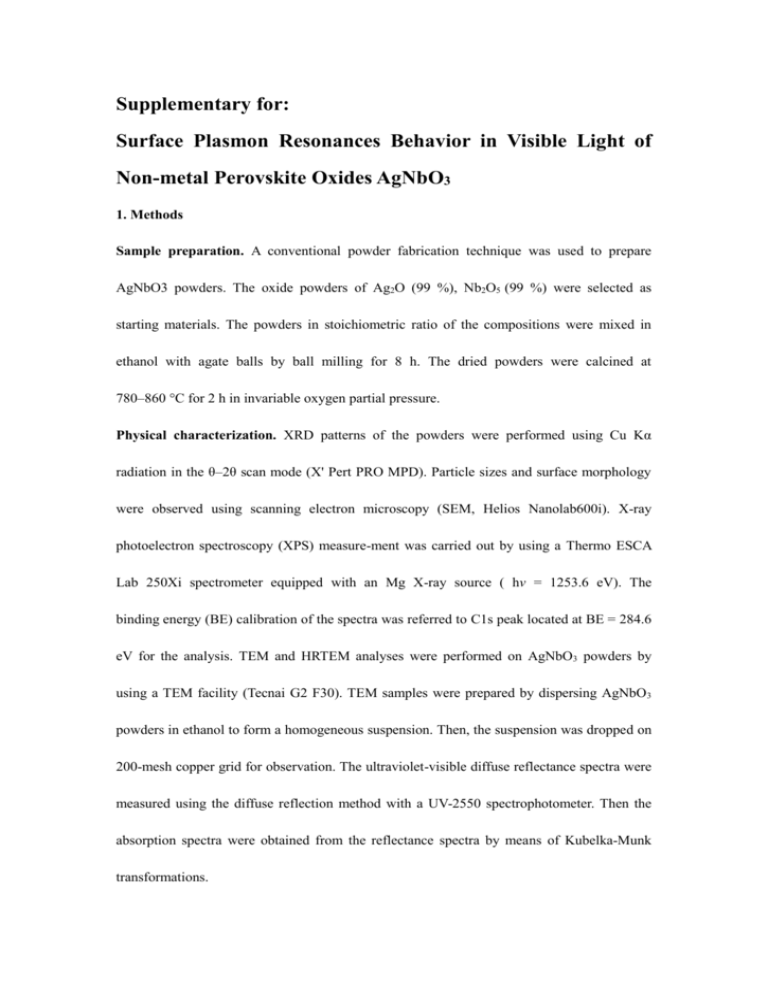supplimentary
advertisement

Supplementary for: Surface Plasmon Resonances Behavior in Visible Light of Non-metal Perovskite Oxides AgNbO3 1. Methods Sample preparation. A conventional powder fabrication technique was used to prepare AgNbO3 powders. The oxide powders of Ag2O (99 %), Nb2O5 (99 %) were selected as starting materials. The powders in stoichiometric ratio of the compositions were mixed in ethanol with agate balls by ball milling for 8 h. The dried powders were calcined at 780–860 °C for 2 h in invariable oxygen partial pressure. Physical characterization. XRD patterns of the powders were performed using Cu Kα radiation in the θ–2θ scan mode (X' Pert PRO MPD). Particle sizes and surface morphology were observed using scanning electron microscopy (SEM, Helios Nanolab600i). X-ray photoelectron spectroscopy (XPS) measure-ment was carried out by using a Thermo ESCA Lab 250Xi spectrometer equipped with an Mg X-ray source ( hv = 1253.6 eV). The binding energy (BE) calibration of the spectra was referred to C1s peak located at BE = 284.6 eV for the analysis. TEM and HRTEM analyses were performed on AgNbO3 powders by using a TEM facility (Tecnai G2 F30). TEM samples were prepared by dispersing AgNbO3 powders in ethanol to form a homogeneous suspension. Then, the suspension was dropped on 200-mesh copper grid for observation. The ultraviolet-visible diffuse reflectance spectra were measured using the diffuse reflection method with a UV-2550 spectrophotometer. Then the absorption spectra were obtained from the reflectance spectra by means of Kubelka-Munk transformations. First-principles calculations. The calculations were carried out using the LDA+U method. Ultrasoft pseudopotentials were applied with a plane-wave cutoff energy of 370 ev. The K-points set is 1×3×3. Parameters U of 8.7 and 5.9 were employed for Ag 4d and O 2p, respectively. ωp of 3.68 ev and Damping constant of 0.06 ev were added in the SPRs absorption calculation. 2. EDS, SAED, and HRTEM analysis of AgNbO3 samples To prove the SPRs effect here is caused by AgNbO3, not due to the Ag abundance1 or the defects2, the ingredients and microstructure of materials are further investigated. Figure S1 shows the energy disperse spectroscopy (EDS) of AgNbO3 microcrystal. The ingredients in EDS match well to the mixture ratio, with Ag: Nb = 1: 1. The transmission electron microscopy (TEM) image of this area shows that amount of nanocrystals bind to the surface of grains (Fig. S2a). The selected area is proved to be pure AgNbO3 by their selected area electron diffraction (SAED) patterns along the [221] zone axis (insert in Fig. S2a). The same result for those nanoparticles also can be acquired from the High Resolution TEM (HRTEM) analysis (Fig. S2b). The different crystal indexes (110), (204) and (114) mean that the nanoparticles grow anisotropically with various seeds. 3. Hubbard U parameters setting in calculation In this work, the exchange-correlation energy functional was represented by the local density approximation (LDA). The valence configurations of the pseudo potentials are 4d105s1 for Ag, 2s22p4 for O. The on-site Coulomb repulsion (Hubbard U) was applied for both Ag d and O p states. The parameter U was determined by calculating the energy difference between the addition and the removal of an electron from the atomic subshell: Uion (Ag+ d) = (Etot(d10) – Etot(d9)) − (Etot(d9) – Etot(d8)) = 13.92ev. Similarly, Uion (O2- p) = (Etot(p6) – Etot(p5)) − (Etot(p5) – Etot(p4)) = 9.5ev. 3 In consideration of the screening effect in bulk AgNbO3, a common parameter a was multiplied to reproduce the experimental band gap value. Then, the Ubulk (Ag d) = 8.7 ev and Ubulk (O p) = 5.9 ev were obtained. 4. Mulliken populations analysis for Pmc21 AgNbO3 The Atomic Mulliken charge populations (Tab. S1) show the electrons distribution in s, p, and d orbits. It is obviously to see that the O 2p orbits acquire electrons mainly from Nb 4d and Ag 5s orbits. Abundance of electrons remained in O 2p and Ag 4d are responsible for the hybridization of these two orbits. 1.43 electrons of per Nb atoms migrate to O, forming stable covalent bonds. And Ag atoms lose a small amount of electrons (0.75), part of electrons transferring from s to p. Comparison of Ag atoms in the pure metal and AgNbO3 lattice, s, p, and d orbits are all partial occupied, although they exist different levels. It is another reason for the metal-like behavior of Ag in AgNbO3 lattice. Table S2 lists part of the bonding Mulliken charge populations of AgNbO3. It shows that all of Ag-O bonds in (0 0 1) plane are weak anti-bonds, which indicates that electrons of Ag atoms in this plane contribute little to form stable bonds with O. Otherwise, higher population values (0.16~0.17) were acquired between Ag-Ag, revealing the metal-like characteristic. Strong covalent bonds are observed in Nb-O with population values ranging from 0.38 to 0.75. It is of critical important to construct the stable titled NbO6 Octahedrons of perovskite structure. 5. Elevated LSPRs absorbance of AgNbO3 microcrystal with improved morphology In consideration of the fact that the different morphologies may affect the LSPRs absorbance seriously, supplementary experiments such as the optic responses of AgNbO3 sintered at different temperatures were also carried out and the results indicate that the improved crystallinities and microstructures can elevate the LSPRs absorbance. XRD patterns of different sintering temperatures from 800 °C to 860 °C show that all of samples are pure AgNbO3 (Fig. S3). They have the same eigen-absorption bands locating at 450 nm (Fig. S4a), but their LSPRs absorption intensities increase first to the ultimate value of 0.37 at 820 °C (see insert in Fig. S4a), and then decrease gradually with increasing temperature. The various morphologies will explain their different absorption properties. Figure S4b, c, d, and e are the SEM images of samples sintered at 800 °C, 820 °C, 840 °C, and 860 °C respectively. By comparing these four images it is found the degrees of crystallinity are improved by increasing sintering temperature. Though the grain size increases gradually and approached 1μm single particle at 860 °C (shown in Fig. S4e), it contributes little to the LSPRs absorbance directly. The exceptional absorption response at 820 °C ascribes to the sharp edges and corners self-assembled in the sintering process between randomly connected crystal particles. As it was reported in recent studies, the smooth surfaces of materials can extend the SPs propagation lengths, 4 Such as shown in figure S4b, the crystal particles are in the preliminary stage with relatively smooth morphology. While the rough surfaces5 and structure singularities6 will localize and manipulate SPs in limited distance. Structure singularities of the edges and corners are mainly responsible for the better absorption properties of samples sintering at 820 °C and 840 °C (see Fig. S4c and d). The improved LSPRs absorptions caused by structure singularities delineate a versatile and effective route to achieve high-performance of absorption response in device application. 6. Reference 1 W. L. Wang, G. Q. Li, Y. Bai, N. Yang, and W. F. Zhang, J Phys Chem Solids 72 (12), 1457 (2011). 2 G. Li, S. Yan, Z. Wang, X. Wang, Z. Li, J. Ye, and Z. Zou, Dalton Trans 40, 8519 (2009). 3 A. Janotti, D. Segev, and C. G. Van de Walle, Phys. Rev. B 74 (4) (2006). 4 P. Nagpal, N. C. Lindquist, S. H. Oh, and D. J. Norris, Science 325 (5940), 594 (2009). 5 Y. Luo, A. Aubry, and J. B. Pendry, Phys. Rev. B 83 (15), 155422 (2011). 6 Y. Luo, J. B. Pendry, and A. Aubry, Nano Lett. 10 (10), 4186 (2010). FiG. S1. EDS of AgNbO3 microcrystal. Inset shows the atomic ratio of different atoms. FIG. S2. (a) SAED patterns along the [221] zone axis. (b) HRTEM analysis of AgNbO3 nanoparticles. FIG. S3. XRD patterns of the AgNbO3 powders. Dark, red, blue, and the light blue line are samples sintering at 800 ºC, 820 ºC, 840 ºC, 860 ºC, respectively. FIG. S4. (a) Absorption spectrums for AgNbO3 simples calcined at 780ºC (dark line), 800ºC(red line),820 ºC(green line),840 ºC(dark blue line), and 860 ºC(light blue line). Inset shows the absorbance at 584 nm of samples with different sintering temperatures. (b), (c), (d), and (e) are the Surface morphologies of samples calcined at 800 ºC, 820 ºC, 840 ºC, and 860 ºC, respectively. Table. S1. Atomic Mulliken charge populations of AgNbO3 and Ag metal Species Ion s p d Total Charge(e) O 1~24 1.80(1) 4.91(3) 0 6.72(3) -0.72(3) Nb 1~8 2.34 6.51 2.71(2) 11.57 1.43 Ag 1~8 0.17(9) 0.13 9.94(5) 10.25 0.75 Ag metal 1~8 0.60 0.63 9.78 11 0 Table. S2. The bonding Mulliken charge populations of AgNbO3 Bond Population Length (Å) Ag7−O23 Ag8−O24 Ag8−O23 Ag7−O24 Nb2−O4 Nb2−O14 Nb2−O15 Nb2−O5 Nb6−O4 Nb6−O5 Nb6−O14 Nb6−O15 Ag1−Ag7 Ag1−Ag5 Ag4−Ag5 Ag4−Ag7 Ag7−Ag8 -0.06 -0.06 -0.08 -0.08 0.39 0.70 0.38 0.75 0.70 0.38 0.39 0.75 -0.03 -0.03 -0.03 -0.03 0.16 2.446 2.446 2.476 2.476 2.106 1.887 2.128 1.879 1.887 2.128 2.106 1.879 3.842 3.846 3.846 3.842 3.804









